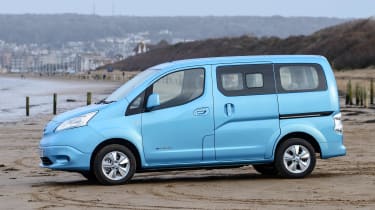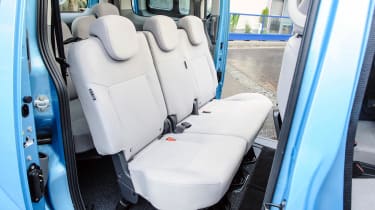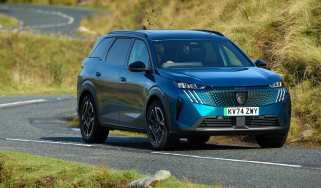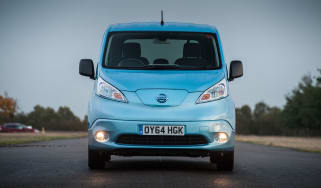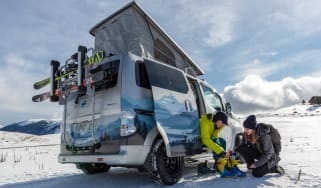Nissan e-NV200 Combi (2014-2022) review
The Nissan e-NV200 Combi is a seven-seat electric MPV that's temptingly affordable, but has been left behind by more recent arrivals to the market
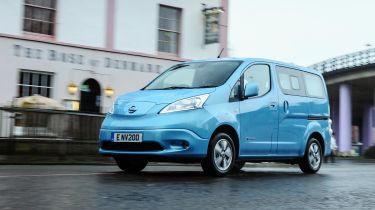
Pros
- Well equipped
- Plenty of space
- Good view out
Cons
- Dated to drive
- Not very stylish
- Van-like interior
| Car type | Electric range | Wallbox charge time | Rapid charge time |
|---|---|---|---|
| Electric | 124 miles | 7hrs 30mins (0-100%, 7.4kW) | 50mins (0-80%, 50kW) |
Nissan brought zero-emissions motoring to the masses with its first-generation Leaf – a model that enjoyed huge sales success around the world. The e-NV200 Combi is its five or seven-seat electric people carrier. It was on sale from 2014 to 2022 alongside the e-NV200 panel van and shares technology with the Leaf.
In 2018, the e-NV200 was updated with the 40kWh battery introduced in the second-generation Leaf, although the rest of the Combi’s running gear is from the first generation. It's therefore no longer at the cutting edge of electric-car technology, and has been comprehensively overtaken by newer arrivals to the market such as the Citroen e-Berlingo, Peugeot e-Rifter and Vauxhall Combo-e Life.
With the addition of the 40kWh battery in 2018, the e-NV200 Combi's driving range was boosted by 60% over the original model. Quoted maximum range is 124 miles, and while cold weather will affect that, the Combi is available with an interior pre-heating function, so at least you can set the temperature before you set off, saving the battery for driving and maintaining the temperature.
There's a trio of charging options under the flap in the nose (similar to the one on the Leaf) with two sockets. The larger socket is for use with CHAdeMO rapid chargers, although this is only standard on higher-spec Acenta and Evalia versions. This can top up the battery from less than a quarter of its capacity to over three-quarters full in 50 minutes. The second socket is the conventional connection to the 6.6kW on-board charger. This offers a seven-and-a-half-hour charge from a home wallbox, while using a regular three-pin socket really strangles the charging rate, taking 21 hours to fully charge the battery from flat.
The e-NV200 Combi comes in Visia, Acenta and Evalia trims. Visia makes do with steel wheels and plastic trims, black plastic bumpers, fixed windows for the sliding doors and a top-hinged tailgate that makes it easy to tell the Combi apart from the e-NV200 van.
Only two speakers are fitted to the stereo, but you do get a USB socket and Bluetooth phone connection, while a push-button starter is fitted. Options include the rapid charger function that’s standard on the Acenta and Evalia, plus the Heat Pack that helps save battery energy by pre-heating or cooling the interior before you set off. Rapid charging, automatic air-conditioning, sliding side-door windows and a reversing camera are added to Acenta cars, while battery heating and cooling is included to help maintain its charge.
Evalia cars add sat nav (an option on Acenta) while automatic lights and wipers are also included. Body-coloured bumpers and 15-inch alloy wheels improve the e-NV200’s looks, while tinted privacy glass is included, too. Thanks to its improved looks, Evalia trim is the model we’d go for, as it’s the least van-like version in the range.
Under the metal, the e-NV200 Combi uses the battery pack from the current Nissan Leaf, with the rest of the electrical running gear sourced from the previous-generation Leaf. Its platform is shared with older Nissan models such as the Juke SUV and Note MPV. With 107bhp, the electric motor isn’t the most powerful, but all the power is available from zero revs, which helps the Combi get off the line and from 0-62mph in 14 seconds. It feels quick enough from a standing start, but runs out of steam at about 40mph – especially with a full set of passengers.
The weight of the batteries contributes to this slow performance, but also settles the ride somewhat compared to a diesel NV200. However, the firm suspension is far from comfortable, crashing over bumps in the road. Light steering helps around town and the big glass area means visibility is good, but the e-NV200 Combi is definitely more about getting from A to B rather than enjoying the journey.
The square body of the Nissan means there’s decent room for seven on board, but using all the seats doesn't leave much boot space to speak of – Nissan quotes a figure of 600 litres to the roof in seven-seat mode. The five-seater has 1,500 litres of space available (to the roof line).
The addition of the latest Leaf’s battery pack means the Combi has the everyday range to suit families that do lots of short trips, but it’s still very van-like in most respects. While that benefits interior space, it’s not much fun to drive, and you only get the most desirable car-like kit if you go for the top-spec Evalia. For a more detailed look at the Nissan e-NV200 Combi, read on for the rest of our in-depth review...

